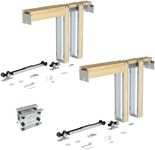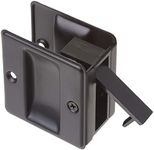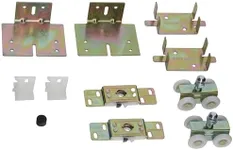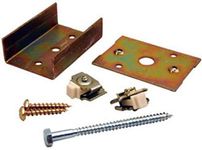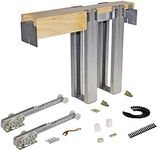Buying Guide for the Best Pocket Door Kits
Choosing the right pocket door kit is all about understanding your space, the weight and size of your door, and how often you expect to use it. Pocket doors are a great way to save space and create a clean, modern look, but the kit you choose will determine how smoothly your door operates and how long it lasts. Before you buy, think about the wall where the door will go, the type of door you want to use, and how much use the door will get. This will help you focus on the features that matter most for your situation.Door Weight CapacityDoor weight capacity tells you the maximum weight the pocket door kit can support. This is important because if your door is too heavy for the kit, it may not slide smoothly or could even damage the track over time. Kits are usually divided into light-duty (up to about 80 pounds), medium-duty (up to about 150 pounds), and heavy-duty (over 150 pounds). If you have a hollow-core or lightweight door, a light-duty kit is usually enough. For solid wood or glass doors, you'll need a medium- or heavy-duty kit. Always check your door's weight and match it to the kit's rating to ensure smooth operation and durability.
Track LengthTrack length is the length of the metal rail that the door slides on inside the wall. It's important because it needs to be at least twice the width of your door to allow the door to fully open and disappear into the wall. Track lengths are often available in standard sizes, but some kits can be cut to fit. Measure your door opening and make sure the kit you choose has a track long enough for your door to slide completely out of sight. If you have a custom-sized door, look for kits with adjustable or customizable tracks.
Wall Thickness CompatibilityWall thickness compatibility refers to the range of wall thicknesses the kit is designed to fit inside. Most pocket door kits are made for standard 2x4 or 2x6 stud walls, but some can be adjusted for thicker or thinner walls. This is important because if the kit doesn't match your wall, installation will be difficult or impossible. Check your wall's construction before buying and choose a kit that matches. If you're renovating or building new, you may have more flexibility, but for existing walls, matching the kit to your wall thickness is key.
Roller and Track QualityRoller and track quality affects how smoothly and quietly your door slides. Higher-quality rollers are usually made from ball bearings or nylon, which last longer and make less noise. Lower-quality rollers may stick or wear out quickly. Kits are often described as having 'standard' or 'premium' rollers. If your pocket door will be used frequently or you want a quiet, smooth operation, look for kits with premium rollers and sturdy tracks. For doors that won't be used much, standard rollers may be sufficient.
Soft-Close and Soft-Open FeaturesSoft-close and soft-open features help the door slow down gently at the end of its travel, preventing slamming and reducing wear. This is especially useful in homes with children or in areas where quiet operation is important. Some kits include these features, while others offer them as optional add-ons. If you value convenience and want to protect your door and frame from damage, consider a kit with soft-close and soft-open mechanisms. If you don't mind manually controlling the door, you can skip this feature.
Ease of InstallationEase of installation refers to how simple the kit is to put together and fit into your wall. Some kits are designed for DIY installation with clear instructions and fewer parts, while others may require more advanced carpentry skills. If you're planning to install the kit yourself, look for one with good instructions and positive reviews about installation. If you're hiring a professional, this may be less important, but easier kits can still save time and money.

